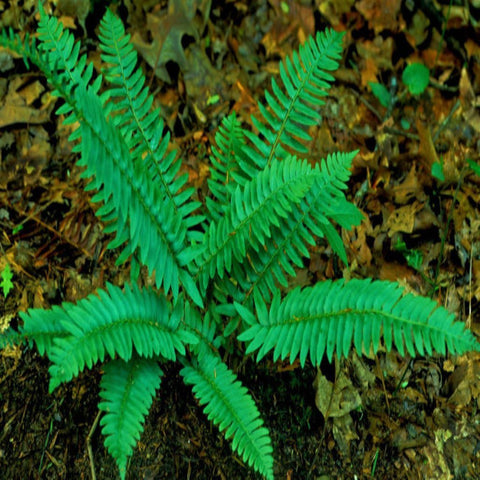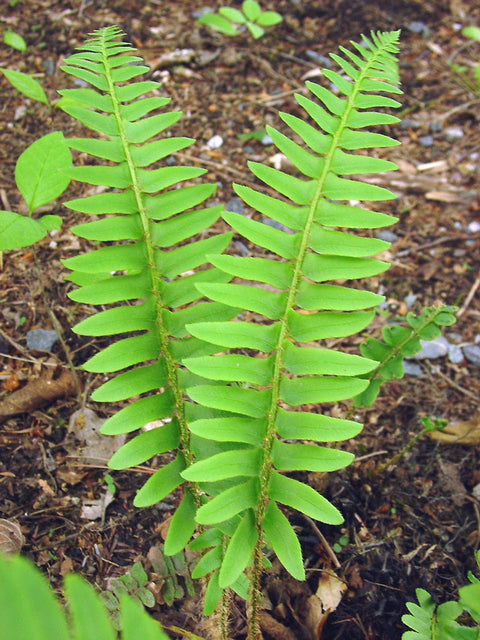

Christmas Fern - Polystichum acrostichoides
The Christmas fern is an evergreen fern native to the eastern United States. The famous ground cover is often used in holiday decorations, and the leaves are lacy and light green and turn bronze in winter. It is a low-maintenance plant that is deer resistant and grows well in various soils.
How does the Christmas fern grow?
These plants flourish in conditions similar to the wet, shaded floor of their native forest habitat, like many fern species. They can handle complete shade, although the spotted, partial shade should be preferred. Be careful to keep them from excessive sun, even though they can withstand more excellent brightness than some fern species if they have enough moisture. This can overstress your Christmas fern, causing the fronds to lose their vibrant green hue and appear washed out, limiting development.
Besides hard clay, all well-drained soil is favorable to Christmas fern growth. Ensure the soil the fern is planted in is not allowed to stand in water during winter to avoid crown rot. The ground should be improved with organic matter and kept moist to ensure the plant operates at its peak. Mulch should be applied all around the plant to retain moisture and provide additional nutrients for growth.
Ferns must have consistent moisture levels to stay solid and vivid. Once a week of watering during the growing season should be sufficient to prevent the soil from being too wet or too dry. Despite ferns' considerable drought tolerance, permitting plants to dry out too much can impede their development and aesthetic attractiveness.
Temperature and humidity
The Christmas Fern does best in cool, shaded areas with temperatures between 50 and 70 ° C. and at least 50% relative humidity. It is not advised to grow this frost-tolerant shrub in hot, dry climates.
Fertilizers
Acid-loving plants don't need much attention, but providing them with the proper care is crucial to preserve their health and growth. One springtime application of an acid-loving plant fertilizer for these plants is typically sufficient, especially if they are grown in soil rich in organic matter.
How to prune Christmas ferns
Pruning should be limited to removing dead or damaged fronds; pruning back the foliage as new fiddleheads form will harm the plant's capacity for photosynthesis. These plants can live for many years if they receive the proper care.
HOW TO PROPAGATE CHRISTMAS FERNS
Christmas fern propagation is creating new plants from the original parent plant. The rootball can be divided into smaller pieces and planted in different locations, or the spores can be collected and sown into the ground. The young ferns will develop into mature plants in either scenario. Follow these steps,
Obtain mature Christmas ferns by buying them or collecting them from an area where they are naturally growing.
- Discard any old fronds to make room for new growth.
- Cut the root ball into sections, ensuring each one contains healthy roots and an established rhizome.
- Plant the sections in containers with well-drained potting soil.
- Water the ferns in a spot with partial shade and high humidity.
- Feed the ferns once a month with an organic, balanced fertilizer.
- Monitor the ferns for any signs of disease or pests, and take appropriate action if needed.
- Divide the ferns every three to four years to maintain healthy growth.
- Propagate new plants by taking stem cuttings in the spring and planting them in moist, well-draining soil.
BUY CHRISTMAS FERN ONLINE AT NANCE PLANTS.
FAQ
1. Do Christmas ferns multiply?
A. Christmas ferns (Polystichum acrostichoides) can multiply and spread, primarily through a process known as vegetative reproduction. Christmas ferns have rhizomes, which are underground horizontal stems. These rhizomes can produce new fronds, allowing the fern to spread and form colonies.
2. Do Christmas ferns come back every year?
A. Yes, Christmas ferns (Polystichum acrostichoides) are perennial plants, meaning they come back every year from the same root system. Christmas ferns are known for their evergreen fronds, which remain green throughout the winter.
Always ensure that you protect your fern from the wrong growing conditions. Poor conditions will make the fern leaves drop, be yellow or have the tips turn brown. With proper care, the tree can survive up to 15 years.
One Year Guarantee on all Perennials & Ferns. See Healthy Plant Guarantee for more details.
Color:
Green
Ships As:
Root/Rhizome
Season:
Late Spring, Summer, Fall
Height:
24-36 Inches
Zone:
3-8
Exposure:
Full to Partial Shade
Deer Resistant:
Yes
Native:
Yes




